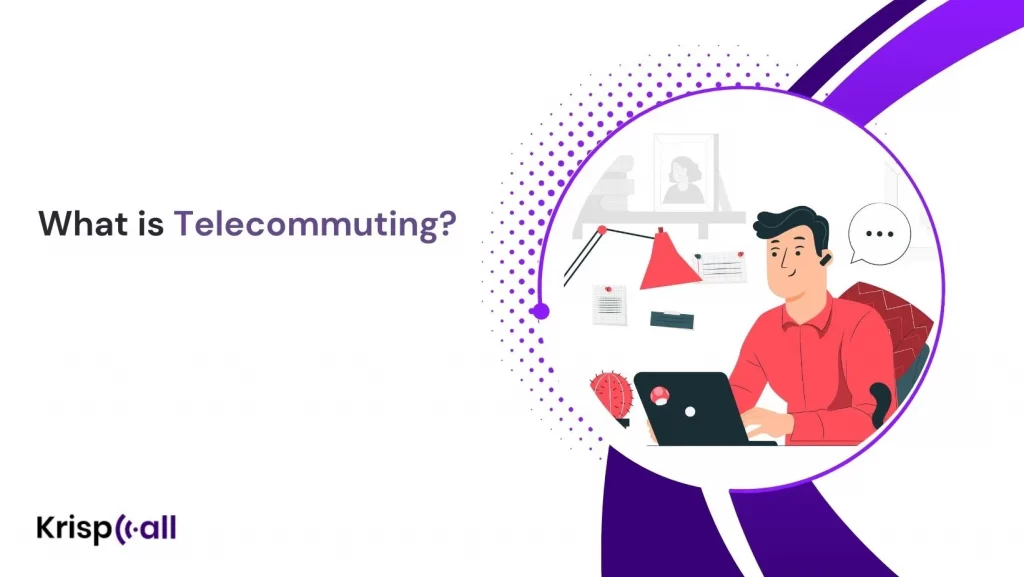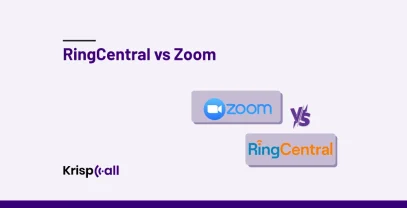Are you sick of your work schedule having little flexibility, long commutes, and workplace distractions?
Ever wondered if there’s a better way to maintain a balance between your personal and professional lives?
If so, telecommuting could be the solution 😀 you’ve been looking for.
According to the survey, “the percentage of employees telecommuting has increased from 20% in 2020 to 28% in 2023. ”
Telecommuting lets you work from anywhere other than the standard office helping you to improve your work-life balance.
In this blog, you’ll learn what telecommuting is, its benefits, challenges, types, and tips for managing telecommuting teams.
Without any delay, let’s get started. 👇
🔑 Key Highlights
- Telecommuting is a work arrangement where employees can work usually from home or other locations other than the standard office spaces.
- Full-time telecommuting, hybrid telecommuting, freelance telecommuting, travel telecommuting, and temporary telecommuting are the 5 types of telecommuting.
- Some of the benefits of telecommuting include improved work-life balance, increased productivity, improved job satisfaction, and reduced operational costs, whereas challenges are isolation and loneliness, technical difficulties, security concerns, and others.
- KrispCall can be used as a modern telecommuting system to improve call quality with its noise cancellation technology helping you to block disturbed annoying sounds.
What is telecommuting?
Telecommuting, also known as teleworking, is a work arrangement where employees can work usually from home or other locations other than standard office spaces. To attend meetings and communicate virtually with colleagues, telecommuters may use phone and internet access.

It involves working from home, using coworking spaces, or using satellite offices based on the employer’s policies and preferences. Employees who telecommute can balance their personal lives and work by having more flexibility and freedom in regulating their work schedules and locations.
For example Jhon a remote software developer employed by a tech corporation, instead of commuting, he works from his home office, connecting to the company’s VPN. He uses chat apps and video calls to collaborate with his colleagues. He also uses project management software and sticks to a set timetable to stay productive. He likes to spend time with his family without the need for a commute. John completes his work responsibilities from home by telecommuting.
What are the types of telecommuting?
There are various ways to set up telecommuting to fit different work styles and organizational requirements.
Here are some types of telecommuting:
1. Full-time telecommuting
It involves employees working solely from a remote location, from their home office for their entire workweek. Flexibility and autonomy are provided by these arrangements but also can pose challenges like communicating with coworkers and establishing boundaries between work and personal life. Despite this, it’s growing in popularity and changing the dynamics of traditional offices.
2. Hybrid telecommuting
Employees who participate in hybrid telecommuting divide their work days between an office and a remote site, providing a balance between flexible remote work and in-person collaboration. In addition to supporting work-life balance and accommodating diverse work preferences, it combines the advantages of in-person engagement with the ease of remote work.
3. Freelance telecommuting
This allows self-employed individuals to work remotely and offer their services to clients. Although this arrangement allows for freedom and autonomy, it also may require entrepreneurial skills and self-discipline to manage workflows and secure clients.
4. Travel telecommuting
Travel telecommuting involves jobs, such as sales or consulting, but also permits remote work during non-travel periods. In between travel assignments, employees can work remotely from various places like hotels, client sites, or their home base. It enables employees to remain productive when traveling offering flexibility and continuity in the workplace.
5. Temporary telecommuting
Due to unanticipated events like bad weather or pandemic, temporary telecommuting allows employees to work remotely for a limited time. This strategy preserves business operations while ensuring employee safety. It provides flexibility and continuity in the workplace but requires effective communication and collaboration tools for remote team members.
Where is telecommuting used?
Different businesses and jobs can use telecommuting, but certain professions are just more naturally suited to remote work than others.
Some of the few industries where telecommuting is frequently used are:
- IT: Since their jobs require computers and internet connection, software developers, programmers, system analysts, and other IT professionals can work remotely with ease.
- Customer service: Through phone calls, emails, chats, call center agents, and technical support specialists can often assist remotely.
- Marketing and communications: Content writers, graphic designers, social media managers, and public relations specialists can telecommute as the main focus of this job is developing and creating content, which can be done virtually.
- Finance and banking: As long as there is secure access to the required data and tools, a lot of financial institutions allow employees to work from home or office satellite through telecommuting for tasks such as bookkeeping, data entry, financial analysis, and tax preparation.
- Education and training: Online instructors, tutors, and instructional designers who provide students worldwide with virtual learning experiences use telecommuting.
What are the benefits of telecommuting?
Telecommuting offers various benefits for both employees and the company. Telecommuting has some significant benefits.
- Improved work-life balance: By removing the need for a daily commute and saving time and stress, telecommuting improves work-life balance. People can better handle personal tasks, appointments, and childcare duties due to their increased flexibility.
- Increased productivity: Since telecommuters have the freedom to work when they are most focused and experience fewer distractions in a home office environment, telecommuting often leads to higher productivity.
- Improved job satisfaction: The flexibility and work-life balance of telecommuting provide higher employee satisfaction and morale. The flexibility to customize work schedules to better suit personal preferences and responsibilities lowers stress levels and improves general well-being for employees working remotely.
- Reduced operational costs: Telecommuting helps businesses save money on operating expenses. Organizations can save significant amounts of money on office space rentals, utilities, and office supplies by using a remote workforce. Also, the employees don’t have to spend money each week on transportation and parking.
- Increased employee retention: Telecommuters can be more productive because the employees can focus more intently on their work without being distracted by the usual office setting interruptions, noise, and long commutes. Also, it encourages trust and independence, enabling staff members to take responsibility for their jobs and produce outcomes.
Along with benefits, it can also be a source of many challenges. Some of the drawbacks of telecommuting are:
- Isolation and loneliness: Employees who work remotely may experience emotions of loneliness and isolation, as they have missed out on the opportunities for social interactions and teamwork that come with working in a regular office setting.
- Technical difficulties: Telecommuters often encounter technical issues since they may hamper productivity and cause workflow disruptions. These disruptions affect coworker collaboration and communication, which results in missed deadlines and lost productivity.
- Management and communication: In order to guarantee productivity and alignment, managing a remote staff has a special problem that calls for efficient communication techniques and well-defined expectations.
- Security concerns: The increasing popularity of telecommuting necessitates that organizations prioritize the implementation of strict security measures to safeguard confidential data from cyberattacks, data breaches, and unauthorized access.
What are the technologies used in telecommuting?
Depending on the industry, technologies used in telecommuting may differ. These technologies help telecommuting to facilitate communication, collaboration, and productivity.
Some of the technologies and tools used in telecommuting are:
- Video Conferencing tools: Use platforms like Zoom, Google Meet, or Microsoft Teams for face-to-face meetings and real-time collaboration despite physical distance.
- Instant messaging: Tools like Slack, Microsoft Teams chat, and Discord allow quick communication, share files, and collaborate on projects through instant messaging and group chats.
- Project management software: Tools such as Trello, Asana, and Basecamp can help you manage tasks, track progress, and keep everyone in the loop.
- Time tracking and productivity tools: Telecommuters can manage their time effectively, track productivity, and remain focused using tools such as Toggl and RescueTime.
Tips for managing telecommuting teams
For telecommuting teams to be successfully managed, clear communication, trust-building, and strategic planning are needed.
Some of the major tips for managing telecommuting teams are:
- Clearly outline the duties, responsibilities, and expectations of the team members who work remotely. To keep everyone accountable and productive, make sure they are all aware of their responsibilities, due dates, and performance indicators.
- Encourage open lines of communication and plan frequent check-ins with team members working from home. Email, chat apps, and video conferencing can all be used to communicate, give feedback, and handle any issues that may come up.
- Ensure team members who work from home have access to the tools, resources, and technology they require to carry out their duties well.
- Encourage teamwork, idea sharing, and information sharing among members of your telecommuting team to create a collaborative team environment.
- Take initiative to recognize and resolve any obstacles or problems that the remote team may encounter. To overcome these challenges be attentive to concerns and offer assistance and direction as required.
KrispCall: A Modern Remote Telecommuting System
In today’s fast-paced world, telecommuting has grown in popularity as more businesses recognize it as a competitive advantage for employees. Introducing KrispCall, an exciting telecommuting solution that enhances collaboration and communication among remote teams.
It removes the obstacle of distance from productive teamwork. Any internet-connected device can access a variety of cutting-edge services like seamless crystal-clear audio.
Its noise cancellation technology is invaluable for remote call center agents, as it reduces background noise during calls ensuring clear and professional communication with customers. Also, KrispCall’s integration with popular communication systems allows remote agents to access its features directly within their workflow, optimizing productivity and streamlining operations.
Whether working from home, in a coworking space, or on the other side of the world, KrispCall enables you to maintain engagement, productivity, and connection.
Try KrispCall Now! 👉Book a free Demo.
Wrapping Up!
Telecommuting offers multiple advantages 😃 for both employees and employers, including better work-life balance, enhanced productivity, and lower operating expenses. However, overcoming the obstacles like isolation, technical difficulties, and lack of collaboration, requires excellent communication, trust-building, and strategic planning.
The success of telecommuting depends on selecting the appropriate tools and keeping up with new developments in remote work technology. Furthermore, optimizing the performance of telecommuting requires keeping up with the recent developments in remote work technology such as remote work management software, collaboration tools, and communication platforms.
KrispCall is the best solution for clear communication, as it has a strong noise cancellation technology that blocks out annoying background sounds.
FAQs
What is the difference between telecommuting and remote work?
The difference between telecommuting and remote work is
| Telecommuting | Remote work |
| It indicates that the worker is located closer to the office location and may expected to occasionally come into the office. | It can operate from any location in the world and is not required to visit an actual workplace. |
| It follows traditional work hours with the employee, spending the entire day online. | It is more flexible as employees can set their hours based on their productivity and location. |
What is a telecommuter?
A telecommuter is a person who works remotely, usually from home or another location other than the standard office environment.





